Welcome to the Ethereum Data Series which covers different types of Ethereum data. This is the first post of the series and will cover some of the basic types of data that are created by the Ethereum blockchain. Each month we’ll release a new post further detailing the types of Ethereum metrics and data.
Types of Ethereum Data
Not all data is created equally on Ethereum. Some data points are defined as usage metrics, others provide key insights into the security of the network, and additional blockchain unique data points describe new stories.
Ethereum has hundreds of commonly referenced data points generated from a combination of on-chain data, user usage, mining, and price data. As blockchain networks continue to evolve, more data metrics will be created and standardized. All of the data below is accessible using Alethio Reporting.
Sign up to create an account and access free Ethereum data.
Ethereum Network Data and Metrics
Using Alethio Reporting we’ll demonstrate some of the reports that are free to access and provide easy explanations of the various types of data points that are measured.
Below we’ll examine the following datasets which can be pulled using Alethio’s free monitoring application:
Top Account Activities
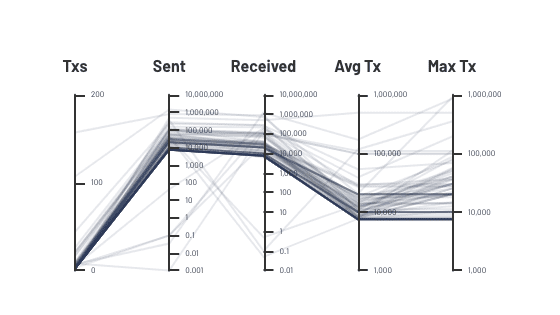
The Top Account Activities dataset consists of the top 100 active Ethereum accounts (sorted by Max Tx value). With this dataset, we can analyze how much ETH a specific account is receiving or sending, the average transaction values, etc. This dataset can be utilized to examine “whales” or large Ethereum external accounts as well as known smart contracts from protocols like Compound.
|
ADDRESS |
Account address |
|
ETH RECEIVED |
Total amount of ETH received by the address |
|
ETH SENT |
Total amount of ETH sent by this address |
|
GAS USED IN WEI |
Total gas spent by this address |
|
COUNTERPARTY ADDRESSES |
The total number of unique addresses with which this address interacted |
|
MINED BLOCKS |
Number of blocks mined |
|
TOTAL TX |
Number of transactions submitted by this address (includes successful and failed transactions) |
|
TX SENT |
Number of transactions sent by the address |
|
TX RECEIVED |
Number of transactions received by the address |
|
AVG TX VALUE |
Average amount of ETH per transaction (sent or received) |
|
AVG SENT TX VALUE |
Average amount of sent ETH per transaction |
|
AVG RECEIVED TX VALUE |
Average amount of received ETH per transaction |
|
LARGEST TX |
Maximum amount of ETH in any transaction (sent or received) |
|
LARGEST SENT TX |
Maximum amount of ETH sent in any transaction |
|
LARGEST RECEIVED TX |
Maximum amount of ETH received in any transaction |
|
TOTAL BALANCE CHANGE |
How much the account balance changed |
Daily Network Statistics
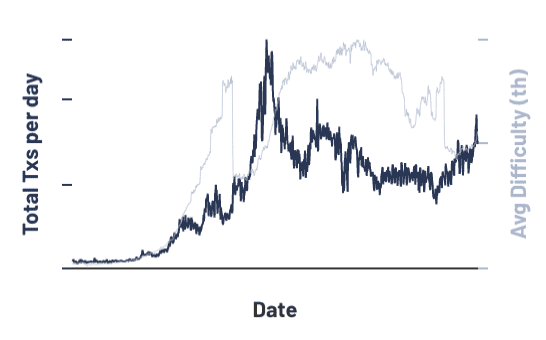
The Daily Network Stats dataset consists of a set of basic metrics around the daily activity on Ethereum mainnet including block time, gas usage, uncle rates, and more. These data points help describe how the Ethereum mainnet is functioning.
|
HIGHEST BLOCK |
highest block number mined on this date |
|
TOTAL BLOCKS |
number of blocks mined |
|
AVERAGE BLOCK TIME |
avg mining time per block (in seconds) |
|
TOTAL UNCLES |
number of uncle blocks integrated into chain |
|
AVERAGE UNCLE RATE |
percentage of uncles calculated from total blocks + uncle blocks |
|
TOTAL TRANSACTIONS |
number of transactions |
|
AVERAGE GAS USAGE |
average gas usage (in % of gas limit) |
|
AVERAGE BLOCK GAS LIMIT |
average gas limit. Gas limit refers to the maximum amount of compute resources an account is willing to pay for to process a transaction on Ethereum. |
|
AVERAGE DIFFICULTY (TH) |
average block difficulty. Measured in terahashes (TH). |
|
AVERAGE HASHRATE (TH/S) |
average hashrate during this date (in TH/s) |
NVT / NVTS Ratios
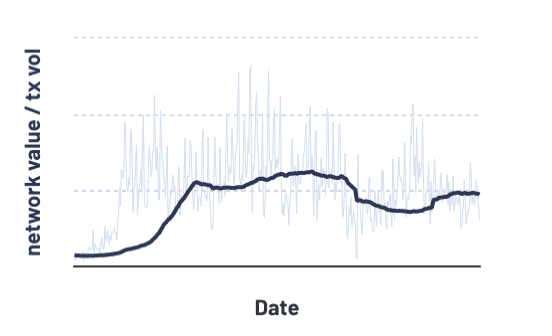
Network Volume Transaction Ratio measures the nominal value of cryptoasset transaction activity compared to network value. NVT is calculated as follows: Network Value / Daily Transaction Volume on Ethereum.
When compared across chains, the Network Volume Transaction Ratio measures a chain’s strength as a payment network compared to its market value. Thus, when the NVT value is higher for a blockchain compared with others, it means it’s more expensive.
Note that on Ethereum, with smart contracts functionalities, we define volume from all the ETH transfer in either value transaction or contract call messages. Mining rewards are also included, according to this definition. Token transfer amount is not included here as it’s difficult to transform the amount into ETH equivalently. This concept was initially introduced by Coinmetrics. Alethio’s results may differ from other sources as the methodology of defining volume may vary.
NVTS (Network Volume Transaction Signal)
Based on the definition of NVT, Willy Woo developed the Network Volume Transaction Signal metrics with the formula as follows: Rather than just using Daily Transaction Volume as in the NVT Ratio, the NVT Signal uses a 90 Day Moving Average of the Daily Transaction Volume. The logic behind using a moving average is to offset the speculation driven growth in on-chain transaction volume that accompanies price movement in the short run.
|
TOTAL SUPPLY |
daily network Value of Ethereum, i.e. the total supply of ETH over time |
|
TX VOLUME |
daily total transferred ETH volume. |
|
NVT RATIO |
Network Volume Transaction Ratio |
|
MA 90 TX VOLUME |
moving average in 90 days of the daily ETH transaction volume |
|
NVTS RATIO |
Network Volume Transaction Signal. Based on 90-day MA of transaction volume. |
Daily Top Accounts
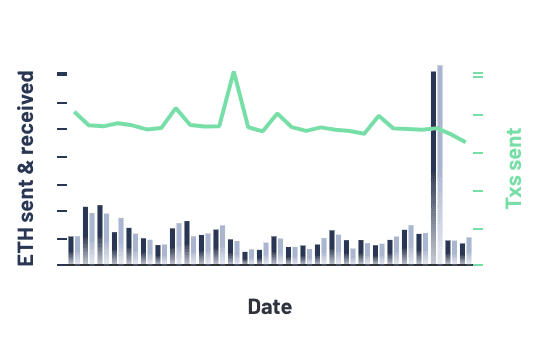
The Daily Top Accounts displays the addresses that sent or received the largest cumulative amounts of ETH and addresses that sent or received the most transactions on a daily basis.
|
MOST AMOUNT OF ETH SENT |
highest amount of ETH sent by one address on this date (aggregated across transactions) |
|
SENDER OF MOST ETH |
the address who sent the highest total amount of ETH in transactions on this date |
|
MOST AMOUNT OF ETH RECEIVED |
highest amount of ETH received by one address on this date |
|
RECIPIENT OF MOST ETH |
the address who received the highest total amount of ETH in transactions on this date |
|
MOST AMOUNT OF TRANSACTIONS SENT |
the most number of transactions sent by one address on this date |
|
SENDER OF MOST TRANSACTIONSMOST AMOUNT OF TRANSACTIONS RECEIVED |
the address who sent the most txs on this datethe most number of transactions received by one address on this date |
|
RECIPIENT OF MOST TRANSACTIONS |
the address who received the most number of transactions on this date |
Daily Account Statistics
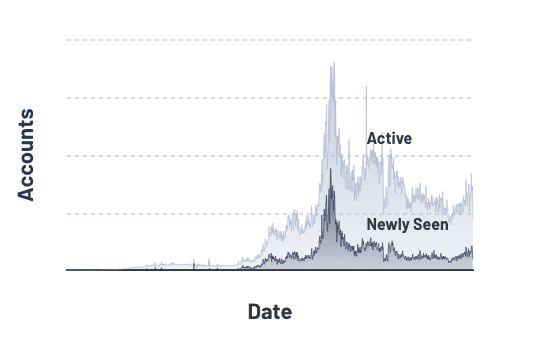
The Daily Account Statistics dataset consists of daily Ethereum account metrics pertaining to activity and account generation. The values reflect the first time an address was active and recorded on the blockchain because it either sent or received a transaction. Total Unique Accounts shows all the created smart contract and external accounts.
|
ACTIVE ACCOUNTS |
total number of active addresses (smart contract accounts and external accounts) |
|
NEW ACCOUNTS |
total number of newly seen addresses (smart contract accounts and external accounts) |
|
TOTAL UNIQUE ACCOUNTS |
cumulative number of unique active addresses (smart contract accounts and external accounts) to date |
Contract Creation and Destruction
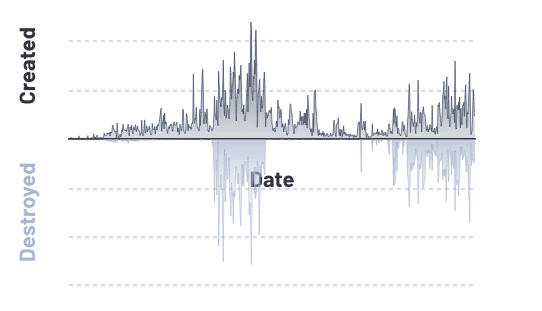
This dataset consists of the daily count of smart contracts being created and destroyed. Note, only successful operations are counted here.
|
SMART CONTRACTS CREATED |
total number of smart contracts created on this date |
|
SMART CONTRACTS DESTROYED |
total number of smart contracts destroyed on this date |
Tx + Contract Call Success Rates
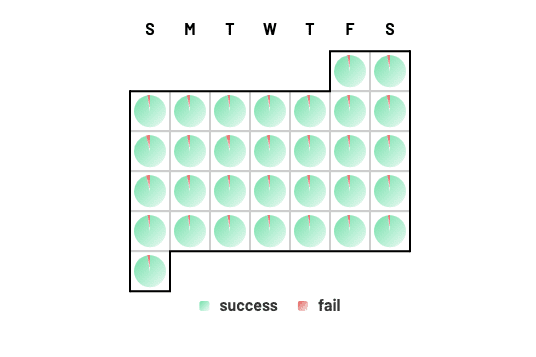
Also self-explanatory, this dataset consists of the daily success rate of transactions–meaning the percent of transactions that are successfully completed.
|
SUCCESSFUL TX |
total number of successful transactions |
|
FAILED TX |
total number of failed transactions |
|
TX SUCCESS RATE |
total number of successful transactions divided by total transactions |
|
SUCCESSFUL CALLS |
total number of successful calls |
|
FAILED CALLS |
total number of failed calls |
|
CALL SUCCESS RATE |
total number of successful calls divided by total calls |
Blockchain technology presents an opportunity to capture all the data created on a network over a network lifetime. The possibilities for data exploration and interpretation are endless. Understanding the fundamentals behind Ethereum and the data that is created will provide added context and insight into how users interact with Ethereum, the security of the network, and more. Stay tuned for our next post in the Ethereum Data Series.
Share this content:
